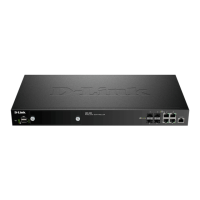D-Link DWC-2000 User Manual 88
Section 4 - Advanced WLAN Conguration
3. Complete the elds in the table below and click Save.
Field Description
AP Prole The name of AP Prole
Radio Mode The radio mode. 802.11a/n or 802.b/g/n
Radio Conguration
State
Specify whether you want the radio on or o by clicking On or O.
If you turn o a radio, the AP sends disassociation frames to all the wireless clients it is
currently supporting so that the radio can be gracefully shutdown and the clients can start
the association process with other available APs.
ON= Radio ON
OFF= Radio OFF
Mode
The Mode denes the Physical Layer (PHY) standard the radio uses.
Select one of the following modes for each radio interface:
• IEEE 802.11a is a PHY standard that species operating in the 5 GHz U‐NII band using
orthogonal frequency division multiplexing (OFDM). It supports data rates ranging from
6 to 54 Mbps.
• IEEE 802.11b/g operates in the 2.4 GHz ISM band. IEEE 802.11b is an enhancement of the
initial 802.11 PHY to include 5.5 Mbps and 11 Mbps data rates. It uses direct sequence
spread spectrum (DSSS) or frequency hopping spread spectrum (FHSS) as well as
complementary code keying (CCK) to provide the higher data rates. It supports data rates
ranging from 1 to 11 Mbps. IEEE 802.11g is a higher speed extension (up to 54 Mbps) to
the 802.11b PHY. It uses orthogonal frequency division multiplexing (OFDM). It supports
data rates ranging from 1 to 54 Mbps.
• IEEE 802.11a/n operates in the 5 GHz ISM band and includes support for both 802.11a
and 802.11n devices. IEEE 802.11n is an extension of the 802.11 standard that includes
multiple‐input multiple‐output (MIMO) technology. IEEE 802.11n supports data ranges
of up to 248 Mbps and nearly twice the indoor range of 802.11 b, 802.11g, and 802.11a.
• IEEE 802.11b/g/n operates in the 2.4 GHz ISM band and includes support for 802.11b,
802.11g, and 802.11n devices.
• 5 GHz IEEE 802.11n is the recommended mode for networks with 802.11n devices that
operate in the 5 GHz frequency that do not need to support 802.11a or 802.11b/g devices.
IEEE 802.11n can achieve a higher throughput when it does not need to be compatible
with legacy devices (802.11b/g or 802.11a).
• 2.4 GHz IEEE 802.11n is the recommended mode for networks with 802.11n devices
that operate in the 2.4 GHz frequency that do not need to support 802.11a or 802.11b/g
devices. IEEE 802.11n can achieve a higher throughput when it does not need to be
compatible with legacy devices (802.11b/g or 802.11a).
• IEEE 802.11n/ac operates in 5GHz ISM band and includes support both 11n and 11ac
devices.
RTS Threshold
Specify a Request to Send (RTS) Threshold value between 0 and 2347.
The RTS threshold indicates the number of octets in an MPDU, below which an RTS/CTS
handshake is not performed.
Changing the RTS threshold can help control trac ow through the AP, especially one with a
lot of clients. If you specify a low threshold value, RTS packets will be sent more frequently. This
will consume more bandwidth and reduce the throughput of the packet. On the other hand,
sending more RTS packets can help the network recover from interference or collisions which
might occur on a busy network, or on a network experiencing electromagnetic interference.

